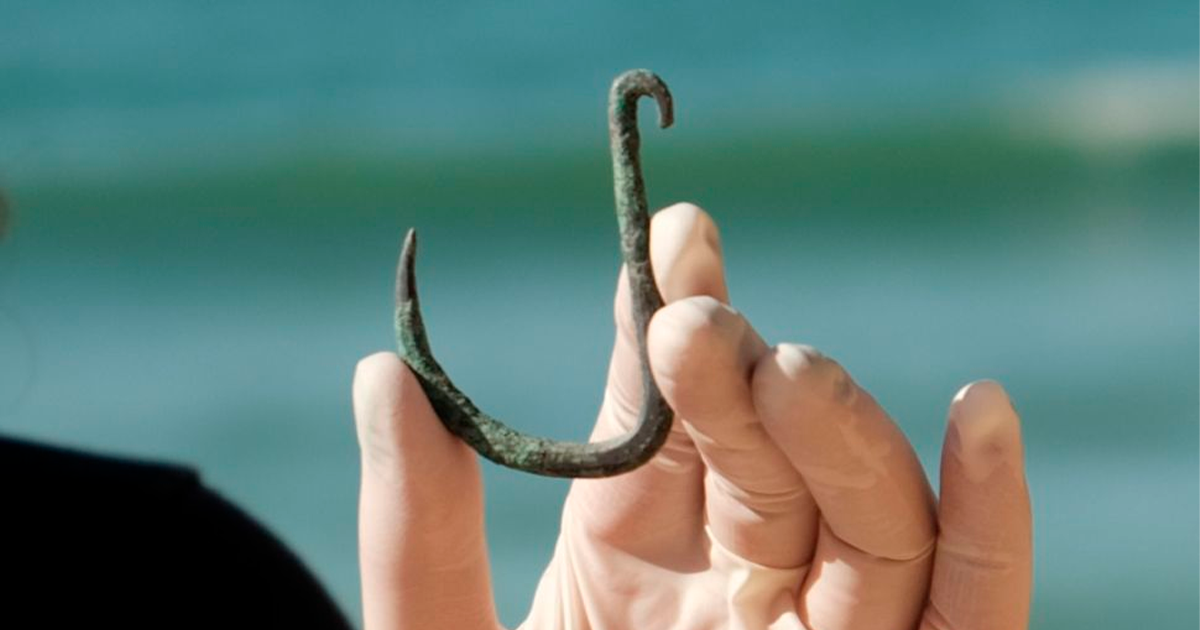
Around 6,000 years ago, people living in what is now Israel may have eaten sharks, according to experts who found a big copper fishing hook in a previously unknown ancient village.
Archaeologists discovered the “shark hook” during a survey along the Mediterranean coast in Ashkelon, a city built on the oldest and largest seaport of ancient Canaan.
The site had already revealed Byzantine and Roman structures, and the new excavation showed parts of a village that dates back 6,000 years to the Chalcolithic period, also called the “Copper Age,” which was between 4500 B.C. and 3500 B.C., in the area.
Dimensions of Fishhook
The hook has a length of approximately 2.5 inches (6.5 centimeters) and a width of approximately 1.6 inches (4 centimeters).
These dimensions make it large enough to catch sharks with a length of between 6.5 to 10 feet (2 and 3 meters), such as dusky sharks and sandbar sharks, as well as large fish such as tuna, all of which are found in the Mediterranean. However, based on what experts know about deep-sea life in the region, sharks were more likely to be the target.

Remarkable Discovery of Shark Hook
According to Yael Abadi-Reiss, an archaeologist with the Israel Antiquities Authority who co-led the excavation, the discovery of the “shark hook” is remarkable because most fishing hooks from this time were smaller and made of bone, and are estimated to be about 42,000 years old.
They were discovered in Southeast Asia, specifically on the island nation of East Timor, in 2005. These prehistoric hooks were also used for deep-sea fishing, specifically for fish the size of tuna.
Archaeologists uncovered a 6,000-year-old copper fishhook at the coastal city of Ashkelon in southern Israel. The excavators believe it could have been used to catch large fish, such as the Atlantic bluefin tuna, or possibly even sharks.
📷Emil Aladjem/Israel Antiquities… pic.twitter.com/yILcIqwtGr— Ticia Verveer (@ticiaverveer) April 4, 2023
She explained that the hook’s size and material (copper) suggest that it may be one of the earliest metal hooks created in the region, as copper was a relatively new material at the time. This suggests that the residents likely included people who were skilled in metalworking and fishing.
However, other findings at the site, such as remains of domesticated animals, suggest that the area’s primary source of income and food would have been traditional agriculture.
Dr. Abadi-Reiss said, “We learn about the dietary habits of the people who lived here 6,000 years ago from the remains of animal bones found in ancient rubbish pits, from burnt wheat grains found in ovens, and from the hunting, cooking, and food-processing tools retrieved, including flint sickles, and a variety of pottery vessels that served for the storage, cooking and the conservation of food by fermentation and salting. The rare fishhook tells the story of the village fishermen who sailed out to sea in their boats and cast the newly invented copper fishhook into the water, hoping to add coastal sharks to the menu.”
See all the latest news from Greece and the world at Greekreporter.com. Contact our newsroom to report an update or send your story, photos and videos. Follow GR on Google News and subscribe here to our daily email!



